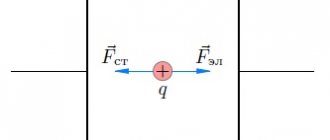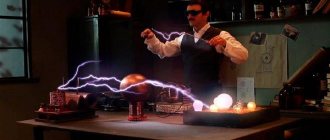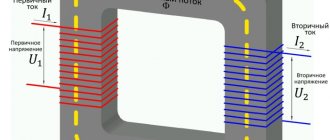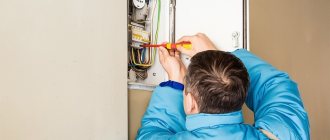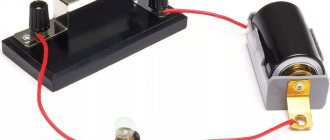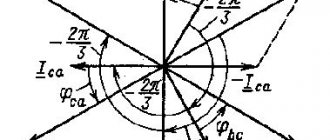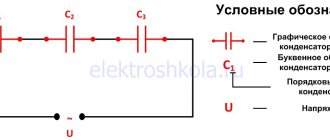Definition Electric current is the directed movement of charged particles under the influence of an external electric field.
Conditions for the existence of electric current:
- the presence of charged particles;
- the presence of an electric field that is created by current sources.
Electric current carriers in various environments
| Wednesday | Electric current carriers |
| Metals | Free electrons |
| Electrolytes (substances that conduct current due to dissociation into ions) | Positive and negative ions |
| Gases | Ions and electrons |
| Semiconductors | Electrons and holes (an atom missing one electron) |
| Vacuum | Electrons |
Electric circuit and its schematic representation
Definition
An electrical circuit is a collection of devices connected in a specific way that provide a path for electric current to flow.
Basic elements of an electrical circuit:
- Current source (generator, galvanic cell, battery, accumulator).
- Current consumers (lamps, heating elements and other electrical appliances).
- Conductors are parts of a circuit that have a sufficient supply of free electrons that can move under the influence of an external electric field. Conductors connect current sources and consumers into a single circuit.
- A key (switch, switch) for closing and opening a circuit.
The electrical circuit may also contain:
- resistor - an element of an electrical circuit that has some resistance;
- rheostat - a device for adjusting the current and voltage in an electrical circuit by obtaining the required resistance value;
- capacitor - a device capable of accumulating electrical charge and transferring it to other elements of the circuit;
- measuring instruments - devices designed to measure the parameters of an electrical circuit.
Definition
An electrical diagram is a graphic representation of an electrical circuit in which real elements are presented in the form of symbols.
Symbols of some elements of the electrical circuit
The simplest electrical circuit contains a current source and consumer, conductors, and a key. It can be shown schematically like this:
How to save energy?
Today there are many options for saving energy. These methods are not at all complicated, but for them to work you need to use them every day. Reducing energy consumption will not only save the family budget, but will also reduce emissions into the environment.
Simple and time-tested saving methods
- Use of energy-saving light bulbs. Such lamps practically do not heat up, so electricity is spent only on lighting. On average, the service life of such lamps is up to 3 years, and this will significantly save costs. Such lamps consume 5 times less electricity, their service life is 10 times longer and pay for themselves in 1 year.
- When using household appliances, it is important to follow the instructions. Let's take the refrigerator for example. It cannot be placed near a stove or radiator, as the device will need to work uninterruptedly to maintain the required temperature. The same applies to the moment when hot food is placed. It is important not to forget to defrost the refrigerator in a timely manner, since ice in the freezer contributes to high energy costs (up to 20%).
- When leaving the room, do not forget to turn off the lights. This advice is the most effective way to save energy.
- Clean light bulbs regularly. At first glance, such advice seems ridiculous. But few people know that dust can block up to 15% of the light. It is important not to forget about the cleanliness of the lampshades. You can use lower wattage lamps.
- Make some minor cosmetic repairs to the room. When choosing wallpaper, you should pay attention to light shades, as they can make the room 80% brighter and more comfortable. We should not forget about the ceiling; it should be made white. This way you will turn on the lights less often.
- Application of heat-reflecting screens. They are made from foil or foam foam. They should be installed behind the battery. Thanks to such screens, the temperature in the room can be raised by several degrees.
- Insulation of the room. It is necessary to insulate the windows or replace them with metal-plastic ones. Up to 30% of heat can be lost through windows. You should hang thick curtains on the windows. If possible, you need to insulate the entrance doors, as well as the walls, ceilings, floors and roofs of the house.
- Purchasing household appliances of class “A”, “A+” and “A++” can save up to 50% of electricity.
- It is not recommended to leave devices in “standby” mode. A person uses any technology for only a few hours during the day. The rest of the time it is in “standby” mode and gradually absorbs electricity. To save money, devices should be turned off from the network.
And so, we already know how many kilowatts are needed for a home. Let's summarize. From what was described above, it follows that if we use electricity sparingly, then we can easily invest in 15 kW, and for a small house this is even enough for heating. Then the whole family will feel comfortable in their cozy nest.
Direction of electric current in metals
Negatively charged electrons move along metal wires, i.e. current flows from “–” to “+” source. The direction of electron motion is called real. But historically in science, the conditional direction of current is accepted from “+” source to “–”.
Actions of electric current (energy conversion)
Electric current can cause various actions:
- Thermal - electrical energy is converted into heat. This transformation is provided by an electric stove, electric fireplace, and iron.
- Chemical - electrolytes undergo electrolysis under the influence of direct electric current. During electrolysis, negative ions (anions) are attracted to the positive electrode (anode), and positive ions (cations) are attracted to the negative electrode (cathode).
- Magnetic (electromagnetic) - in the presence of an electric current in any conductor, a magnetic field is observed around it, i.e. a conductor carrying current acquires magnetic properties.
- Luminous - electric current heats metals to white heat, and they begin to glow like a tungsten spiral inside an incandescent lamp. Another example is LEDs, in which light comes from the emission of photons as an electron moves from one energy level to another.
- Mechanical - parallel conductors with electric currents flowing in one direction attract, and in opposite directions they repel.
Sources and consumers of electrical energy in a car
On any vehicle, the degree to which consumers are supplied with electric current is of great importance.
Its use is determined both by the operating principle of the internal combustion engine and by the need to ensure comfort and conditions for the transportation of passengers and cargo. SOURCES OF ELECTRICAL ENERGY.
At the same time, not every source of electrical energy can be installed on a car. It must be compact, powerful enough and have a long service life. The car uses direct current electrical energy, as it is the most optimal from the point of view of its storage and generation. However, direct current has a peculiarity, which is that the polarity of connecting consumers to sources is constant.
Therefore, the entire electrical system of the car is wired only with a positive wire, and the role of the negative wire is played by the car body. This determines restrictions on the use of electric arc welding units when carrying out body repair and some other work. It is possible to use semi-automatic welding units with the obligatory disconnection of consumers from power sources. Electricity sources include a battery (AB) and a direct current generator (DCG).
The battery is a box that can be removed and installed. In this case, it is necessary to take into account the mounting dimensions of the installation socket. It is designed to store direct current electrical energy to provide consumers with it when the engine is not running and as an emergency when the generator fails. It is divided into jars, inside of which there are special plates, the interaction of which with the electrolyte poured into the jar ensures the appearance and storage of electric current. The electrolyte is sulfuric acid diluted with distilled water to a density of 1.25 - 1.27 g/cm3. The terminals located along the edges of the battery with symbols on them (+) or (-) make it possible to connect consumers to them without confusing the polarities. Rechargeable batteries are marked as follows, for example: 6ST55P .
- 6 – number of cans
- ST is a starter type battery with a starting current of more than 200 A.
- 55 – nominal capacity in A/h.
- P – type of housing (plastic).
It is impossible to discharge the battery by more than 50%, this will lead to irreversible processes inside it. The battery must be recharged (charged) during operation. When driving for a long time (more than 2 hours), this occurs from a running generator. In stationary conditions, the battery can be charged using a special charger. In addition, when the battery is actively discharging and charging, distilled water boils away in the electrolyte, which must be topped up.
A generator is an electrical machine that is driven—the rotation of its rotor—by an engine. It is designed to generate direct current electrical energy during engine operation and provide this energy to all consumers. This is the main type of electricity generation and consumption. When generated electricity exceeds consumption, the excess is sent to recharge the battery.
These include:
- External lighting devices (VSP)
- Ignition system
- Engine starting system
- Instrumentation and lighting of the interior, trunk and hood.
- Windshield wipers and washers.
- Additional electrical devices.
External lighting devices
These include:
Side lights - white at the front, red at the rear, non-flashing.
The rear license plate lighting is white, from the rear, and turns on when the side lights are turned on.
Low and high beam headlights . White color. They turn on one by one (first the low beam, then the high beam), only after the side lights are turned on. They can be washed individually, combined into one block headlight, and also be combined in one lamp, with different lighting threads.
Light direction indicators . Orange color, flashing, located on the front, back and sides. They can perform an additional function - an emergency signal, when all six direction indicator lights flash simultaneously.
Brake lights - rear, two, non-flashing, red.
Reversing lights - at the rear, one or two white, non-flashing.
Additionally, some cars may have fog lights installed - two in front, white, non-flashing. Rear fog lamp, one, red, non-flashing. Ignition system
The working mixture in the cylinders of a carburetor engine is ignited by an electric spark that jumps between the electrodes of the spark plug. The air gap between the electrodes of the spark plug has a high electrical resistance, so it is necessary to create a high voltage between them to cause a spark discharge. Spark discharges must appear at a certain position of the pistons and valves in the cylinders and alternate in accordance with the established order of engine operation.
These requirements are met by an ignition system consisting of current sources (battery and generator), ignition coil, distributor-distributor, capacitor, spark plugs (according to the number of cylinders), ignition switch (lock) (has four positions), high and low wires. low voltage.
The ignition switch has four positions: off, parking, ignition, starter. The ignition key is inserted into the ignition switch.
Using this ignition key, you can select the vehicle use mode as follows.
In the "off" position, the key can be removed and inserted. The anti-theft (mechanical) device is activated. The car cannot be started. Consumers of electrical energy are connected to the battery according to a shortened circuit that meets the driver’s needs when the car is parked.
In the "parking" position, on some cars the key can be removed and inserted, but on others this is not possible. The anti-theft (mechanical) device is turned off. The car cannot be started. Consumers of electrical energy are connected to the battery according to a shortened circuit that meets the driver’s needs when the car is parked.
The key cannot be removed in the ignition position. This is the main position of the key, in which it remains all the time while the engine is running. You can start the car. All electrical energy consumers are connected, when the engine is not running, to the battery, and after the engine is started, to the generator.
The “starter” position is spring-loaded so that after starting the engine, the key returns to the “ignition” position. After starting, the released key returns to the “ignition” position, where it remains as long as the engine is running. Returning the key is mandatory since the starter rotation speed is significantly less than the flywheel rotation speed after starting the engine. If the flywheel and starter remain engaged, the starter may fail.
Turning the key a small angle causes the starter to rotate and start the engine.
In order to stop the engine, the key must be turned to the “parking” or “off” position. Engine starting system
It ensures that the engine starts using a starter, which rotates the flywheel of the flywheel with the obligatory supply of electrical energy to the ignition coil and further along the circuit. If the engine starting system does not allow it to start for reasons related to the battery being discharged, the engine can be started in a backup way. There may be several such methods:
- Using another battery
- With the help of several persons pushing the car
- Using a towing vehicle
- On the descent from the push.
Instrumentation
These may include instrumentation installed in a standard version:
- Speedometer
- Fuel level indicator
- Coolant temperature gauge
- Oil pressure indicator
- Battery charge indicator
- Lamp (lamps in the form of arrows) signaling the turn on of the direction indicator lights (flashing)
- Lamp signaling the inclusion of side lights (low beam)
- Lamp signaling the inclusion of high beams
- A lamp indicating that the parking brake is engaged (flashing) and a brake system malfunction (lit).
Additional electrical devices
These include:
- Sound signal
- Instrument panel lighting
- Radio, radio, etc.
- Electric double glazing
- Retractable antennas, etc.
Basic parameters of direct current
Definition:
Direct current is an electric current that does not change in magnitude or direction over time.
The main parameters of electric current are:
- Current strength. Denoted as I. The unit of measurement is A (Ampere).
- Voltage. Denoted as U. The unit of measurement is V (Volt).
- Resistance. Denoted as R. The unit of measurement is Ohm.
Current strength
The current strength shows how much charge q passes through the cross section of the conductor in 1 second:
I=qt..=ΔqΔt..=Nqet.
N is the number of electrons, qe=1.6·10−19 C is the electron charge, t is time (s).
Charge passing through a conductor in time t at a current strength equal to I:
q=It
Example No. 1. The current source was connected to two plates immersed in a solution of table salt. The current in the circuit is 0.2 A. How much charge passes between the plates in the bath in 2 minutes?
2 minutes = 120 seconds
q=It=0.2·120=24 (Cl)
Charge passing in time ∆t with a uniform change in current from I1 to I2:
Δq=I1+I22..Δt
Current strength and speed of electrons:
I=nqeSv
n - (m–3) - concentration, S (m2) - cross-sectional area of the conductor, v - electron speed.
Attention!
Electrons move along the wires at a speed equal to fractions of mm/s. But the electric field propagates at the speed of light: c = 3∙108 m/s.
Resistance
The resistance of metals characterizes the inhibitory effect of positive ions of the crystal lattice on the movement of free electrons:
R=ρlS..
ρ - resistivity, showing what resistance a conductor with a length of 1 m and a cross-sectional area of 1 m2, made of a certain material, has. l is the length of the conductor (m), S is its cross-sectional area.
Example No. 2. Copper wire has an electrical resistance of 6 ohms. What is the electrical resistance of a copper wire that is 2 times the length and 3 times the cross-sectional area?
Resistance of the first and second conductor, respectively:
R1=ρlS..
R2=ρ2l3S..
Let's divide the electrical resistance of the second conductor by the resistance of the first:
R2R1..=ρ2l3S..÷ρlS..=ρ2l3S..·Sρl..=23..
Hence the resistance of the second conductor is:
R2=23..R1
Voltage
Voltage characterizes the work of the electric field to move a positive charge:
U=Aq.
Example No. 3. When moving a charge in the first conductor, the electric field does 20 J of work. In the second conductor, when moving the same charge, the electric field does 40 J of work. Determine the ratio U1/U2 of the voltages at the ends of the first and second conductors.
U1U2..=A1q..÷A2q..=A1q..·qA2..=A1A2..=2040..=12..
How many kilowatts do you need for your home? Electricity consumption table
Our modern society cannot imagine its life without electricity. It is firmly rooted in the daily and industrial life of a person in the twenty-first century.
Electricity is used not only to illuminate streets, residential buildings and other premises. Today, electricity is needed to power the telephone, computer, TV and many other household appliances in our homes, which make the life of a modern person much easier.
Many home owners use electricity for heating, although this is not the cheapest type of heating, it is quite reliable and easy to use.
Like people in the past, modern society cannot exist without electricity. Every year, scientists are developing new technologies that require power. Of course, today electric current is used more widely than before. But after several decades, its consumption will increase several times. So, for example, if 10 years ago 1.5 - 2 kW of electricity was enough for a house or apartment, today this figure has increased to 15 kW, almost 10 times.
Let's try to figure out how many kilowatts a home currently needs.
Main components of the electrical network
An electric power network (Fig. 5) is a set of electrical installations for the transmission and distribution of electrical energy, consisting of substations, switchgears, conductors, overhead and cable power lines operating in a certain territory.
Figure 5 - Electrical network and electrical installations for transmission and distribution of electrical energy
All circuits encountered in practice are combinations of individual elements - feeders, mains and branches.
Electrical networks, in turn, are divided into main electrical networks and distribution electrical networks.
Trunk networks include all high-voltage power lines (PTLs), distribution networks include power lines with a capacity below 110 kV. Types of electrical networks are presented in Figure 6.
Figure 6 - Types of electrical networks
The networks are interconnected by transformer and distribution substations. To meet the established requirements, power systems are equipped with special control centers equipped with monitoring, control, communication means and special layouts of power plants, transmission lines and step-down substations.
Electrical networks are divided into:
- tension;
- degrees of mobility;
- purpose;
- type of current and number of wires;
- electrical connection diagram:
a) open (non-redundant). A diagram of open-loop networks is shown in Figure 7.
Figure 7 - Schemes of open-loop networks : a - radial (load only at the end of the line); b - main (the load is connected to the line in different places)
b) closed (redundant) (Fig. 8).
Figure 8 — Schemes of closed networks: a — network with two-way power supply; b - ring network; c - double main line; g complex network (for supplying critical consumers in two or more directions)
Main power supply circuits are used in the following cases:
- a) when the load is concentrated in nature, but its individual nodes are located in the same direction in relation to the substation and at relatively small distances from each other, and the absolute values of the loads of individual nodes are insufficient for the rational use of the radial scheme;
- b) when the load is distributed with varying degrees of uniformity.
By design: electrical wiring (power and lighting), current conductors - for transmitting electricity in large quantities over short distances, overhead lines - for transmitting electricity over long distances, cable lines - for transmitting electricity over long distances in cases where the construction of overhead lines is impossible.
The most widespread for local distribution networks are radial, main, mixed (radial-main) and loop schemes.
With a radial power supply scheme, each line is like a beam connecting a network node (substation, distribution point) with a single consumer.
In the main power supply scheme, one line - the main line - serves, as indicated, several distribution points or receivers connected to it at its various points.
Mixed schemes of local distribution networks are used at different locations of consumers relative to the CPU and combine the principles of constructing both radial and main circuits.
The following requirements are imposed on electrical networks: reliability, survivability and efficiency.
Reliability is the main technical requirement, which refers to the ability of a network to fulfill its purpose within a given time and operating conditions, providing electrical receivers with electricity in the required quantity and proper quality.
The survivability of an electrical network is the ability to fulfill its purpose under conditions of destructive influences, including in a combat situation when exposed to enemy weapons.
Cost-effectiveness is the minimum cost of constructing and operating a network, subject to the requirements of reliability and survivability.
